LEXUS LS430 2006 Owners Manual
Manufacturer: LEXUS, Model Year: 2006, Model line: LS430, Model: LEXUS LS430 2006Pages: 419, PDF Size: 11.19 MB
Page 171 of 419
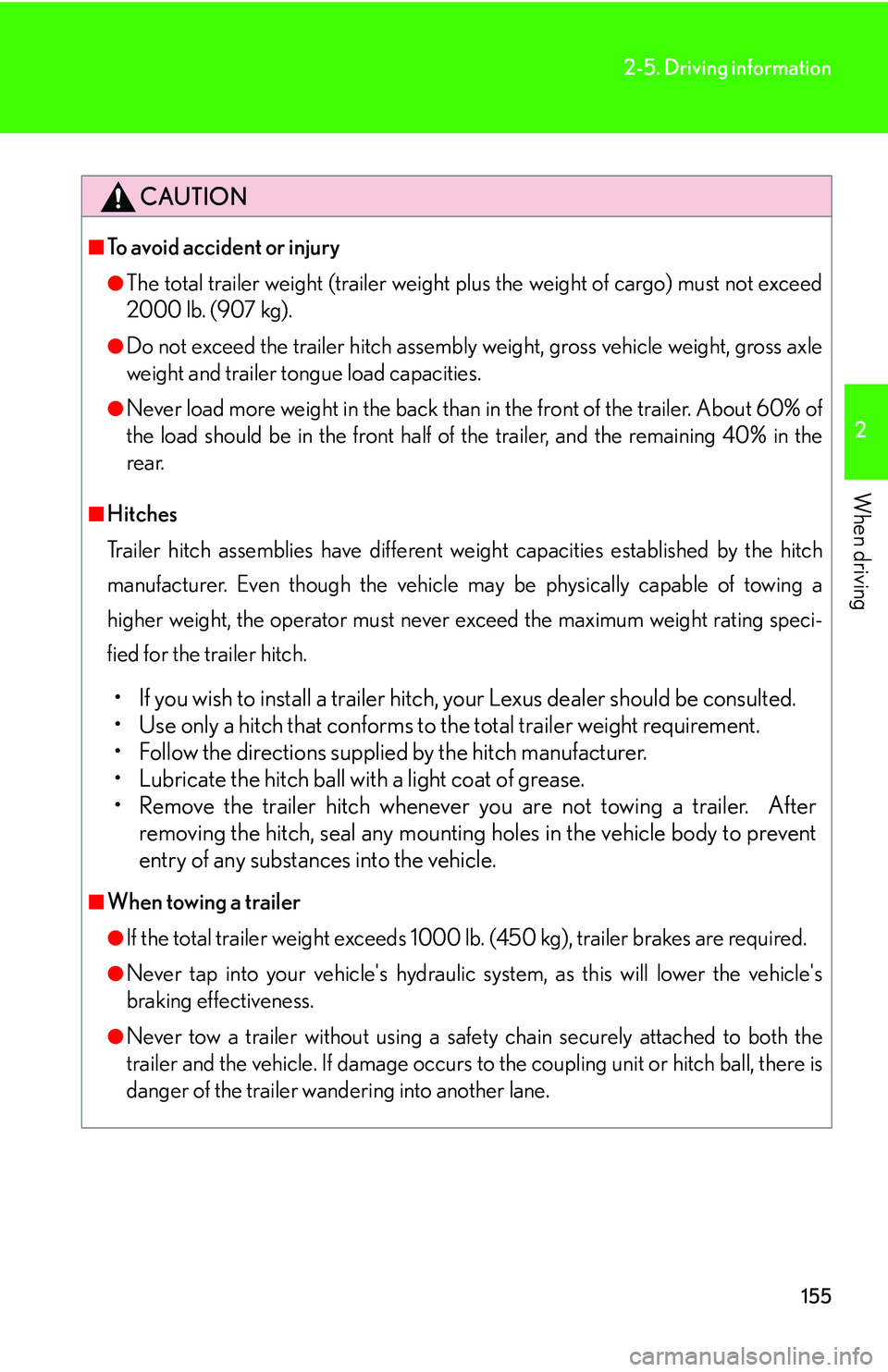
155
2-5. Driving information
2
When driving
CAUTION
■To avoid accident or injury
●The total trailer weight (trailer weight plus the weight of cargo) must not exceed
2000 lb. (907 kg).
●Do not exceed the trailer hitch assembly weight, gross vehicle weight, gross axle
weight and trailer tongue load capacities.
●Never load more weight in the back than in the front of the trailer. About 60% of
the load should be in the front half of the trailer, and the remaining 40% in the
rear.
■Hitches
Trailer hitch assemblies have different weight capacities established by the hitch
ma
nufacturer. Even though the vehicle may be physically capable of towing a
higher weight, the operator must never exceed the maximum weight rating speci -
fied for the trailer hitch.
• If you wish to install a trailer hitch, your Lexus dealer should be consulted.
• Use only a hitch that conforms to the total trailer weight requirement.
• Follow the directions supplied by the hitch manufacturer.
• Lubricate the hitch ball with a light coat of grease.
• Remove the trailer hitch whenever you are not towing a trailer. After r
emoving the hitch, seal any mounting holes in the vehicle body to prevent
entry of any substances into the vehicle.
■When towing a trailer
●If the total trailer weight exceeds 1000 lb . (450 kg), trailer brakes are required.
●Never tap into your vehicle's hydraulic system, as this will lower the vehicle's
braking effectiveness.
●Never tow a trailer without using a safety chain securely attached to both the
trailer and the vehicle. If damage occurs to the coupling unit or hitch ball, there is
danger of the trailer wandering into another lane.
Page 172 of 419
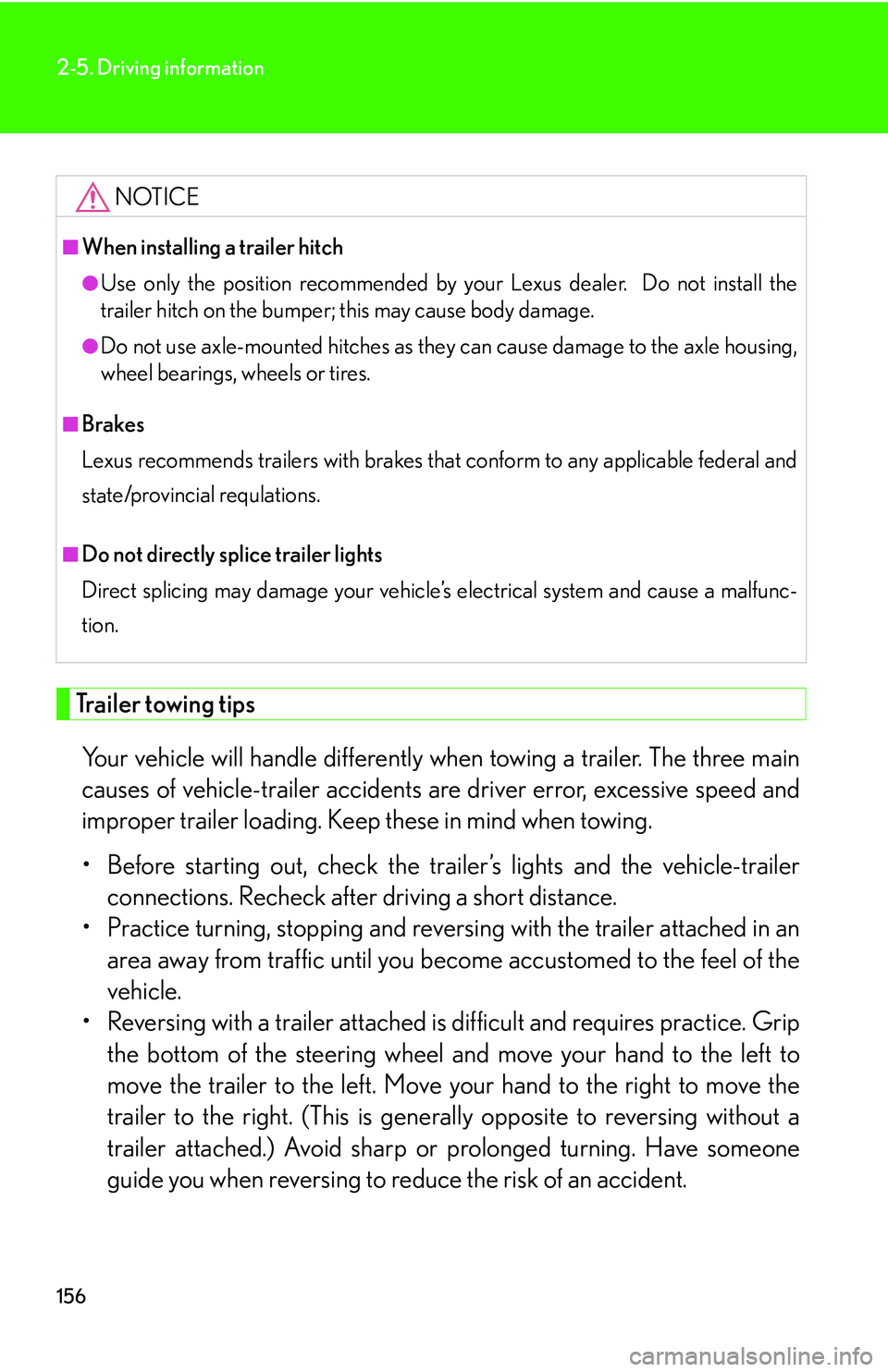
156
2-5. Driving information
Trailer towing tips
Your vehicle will handle differently when towing a trailer. The three main
causes of vehicle-trailer accidents are driver error, excessive speed and
improper trailer loading. Keep these in mind when towing.
• Before starting out, check the tra iler
’s lights and the vehicle-trailer
connections. Recheck after driving a short distance.
• Practice turning, stopping and reversi ng with the tr
ailer attached in an
area away from traffic until you be come accustomed to the feel of the
vehicle.
• Reversing with a trailer attached is dif
ficult and requires practice. Grip
the bottom of the steering wheel and move your hand to the left to
move the trailer to the left. Move yo ur hand to the right to move the
trailer to the right. (This is gene rally opposite to reversing without a
trailer attached.) Avoid sharp or prolonged turning. Have someone
guide you when reversing to redu ce the risk of an accident.
NOTICE
■When installing a trailer hitch
●Use only the position recommended by your Lexus dealer. Do not install the
trailer hitch on the bumper; this may cause body damage.
●Do not use axle-mounted hitches as they can cause damage to the axle housing,
wheel bearings, wheels or tires.
■Brakes
Lexus recommends trailers with brakes that conform to any applicable federal and
sta
te/provincial requlations.
■Do not directly splice trailer lights
Direct splicing may damage your vehicle’s electrical system and cause a malfunc -
tion.
Page 173 of 419
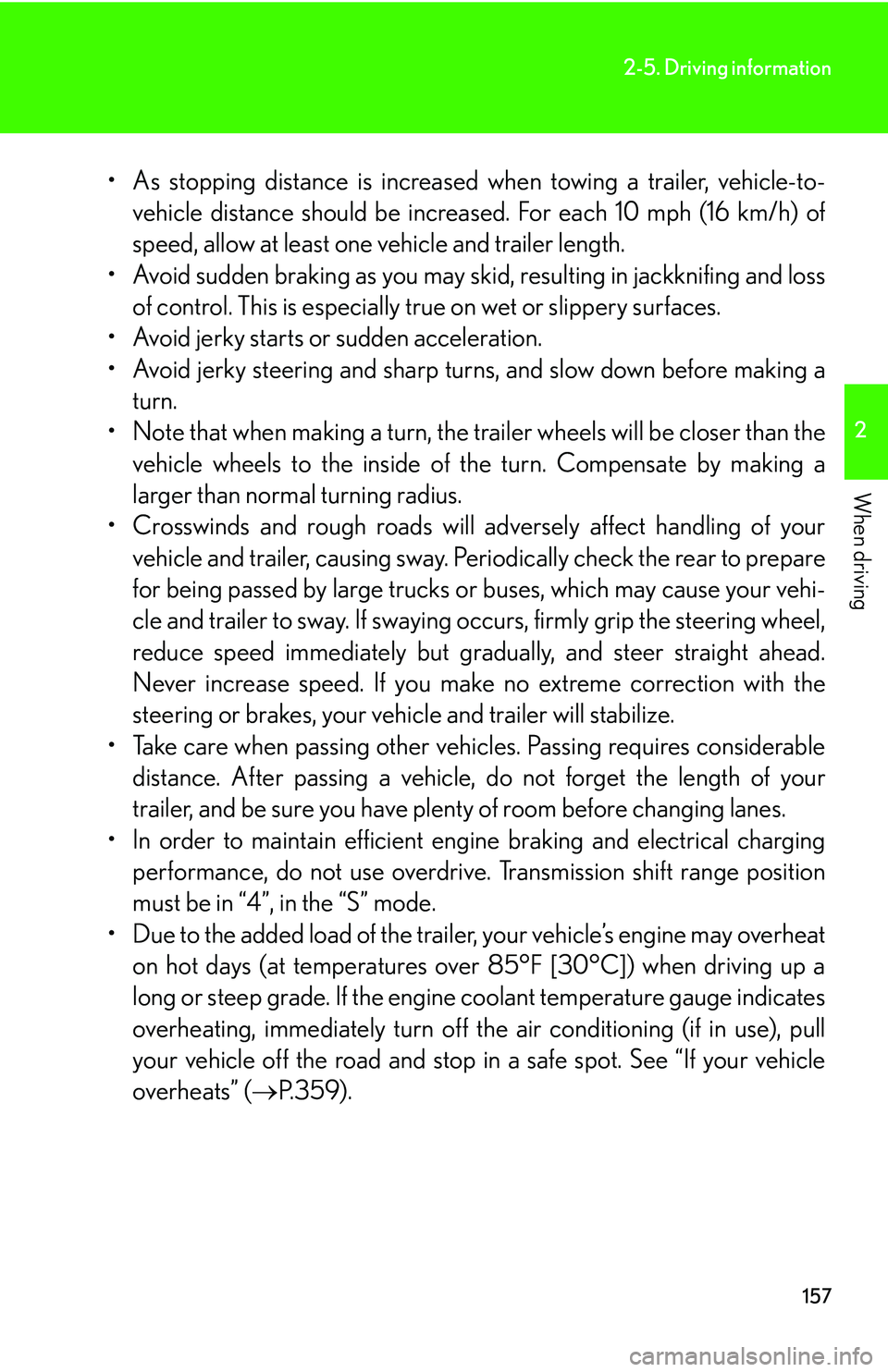
157
2-5. Driving information
2
When driving
• As stopping distance is increased when towing a trailer, vehicle-to-
vehicle distance should be increas ed. For each 10 mph (16 km/h) of
speed, allow at least one vehicle and trailer length.
• Avoid sudden braking as you may sk id, r
esulting in jackknifing and loss
of control. This is especially true on wet or slippery surfaces.
• Avoid jerky starts or sudden acceleration.
• Avoid jerky steering and sharp turn s, and slo
w down before making a
turn.
• Note that when making a turn, the tr ailer wheels will be closer than the
v
ehicle wheels to the inside of th e turn. Compensate by making a
larger than normal turning radius.
• Crosswinds and rough roads will ad v
ersely affect handling of your
vehicle and trailer, causing sway. Peri odically check the rear to prepare
for being passed by large trucks or buses, which may cause your vehi-
cle and trailer to sway. If s
waying occurs, firmly grip the steering wheel,
reduce speed immediately but gradually, and steer straight ahead.
Never increase speed. If you make no extreme correction with the
steering or brakes, your vehi cle and trailer will stabilize.
• Take care when passing other vehicl es. P
assing requires considerable
distance. After passing a vehicle, do not forget the length of your
trailer, and be sure you have plenty of room before changing lanes.
• In order to maintain efficient engine br
aking and electrical charging
performance, do not use overdrive. Transmission shift range position
must be in “4”, in the “S” mode.
• Due to the added load of the traile r
, your vehicle’s engine may overheat
on hot days (at temperatures over 85°F [30°C]) when driving up a
long or steep grade. If the engine coolant temperature gauge indicates
overheating, immediately turn off the air conditioning (if in use), pull
your vehicle off the road and stop in a safe spot. See “If your vehicle
overheats” ( P.359 ).
Page 174 of 419
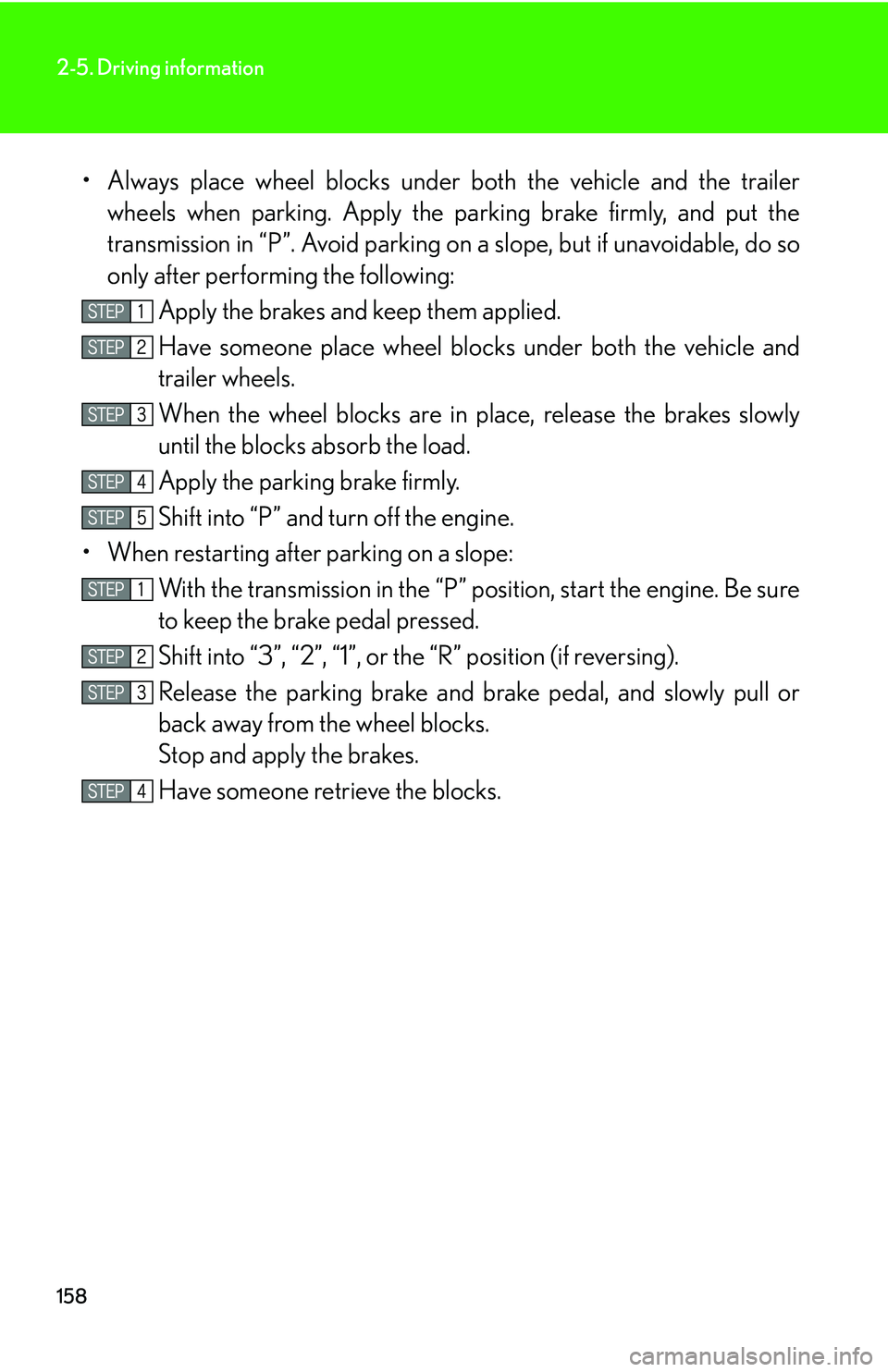
158
2-5. Driving information
• Always place wheel blocks under both the vehicle and the trailer
wheels when parking. Apply the pa rking brake firmly, and put the
transmission in “P”. Avoi d parking on a slope, but if unavoidable, do so
only after performing the following:
Apply the brakes and keep them applied.
Have someone place wheel blocks under both the v
ehicle and
trailer wheels.
When the wheel blocks are in pl ace, r
elease the brakes slowly
until the blocks absorb the load.
Apply the parking brake firmly.
Shift into “P” and turn off the engine.
• When restarting after parking on a slope:
With the transmission in the “P” position, star
t the engine. Be sure
to keep the brake pedal pressed.
Shift into “3”, “2”, “1”, or the “R” position (if r
eversing).
Release the parking brake and br ak
e pedal, and slowly pull or
back away from the wheel blocks.
Stop and apply the brakes.
Have someone retrieve the blocks.
Page 175 of 419
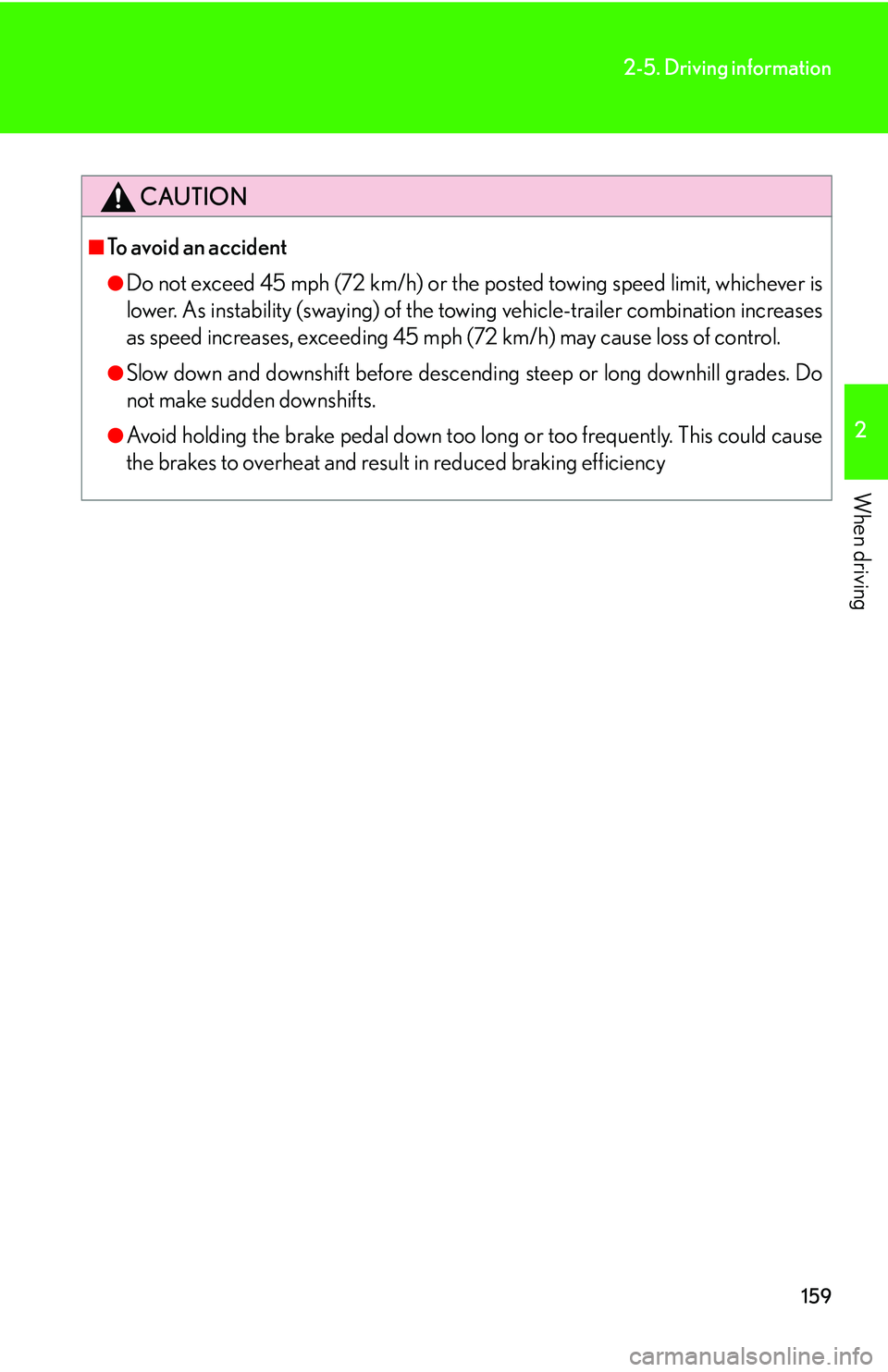
159
2-5. Driving information
2
When driving
CAUTION
■To avoid an accident
●Do not exceed 45 mph (72 km/h) or the posted towing speed limit, whichever is
lower. As instability (swaying) of the towing vehicle-trailer combination increases
as speed increases, exceeding 45 mph (72 km/h) may cause loss of control.
●Slow down and downshift before descending steep or long downhill grades. Do
not make sudden downshifts.
●Avoid holding the brake pedal down too long or too frequently. This could cause
the brakes to overheat and result in reduced braking efficiency
Page 176 of 419
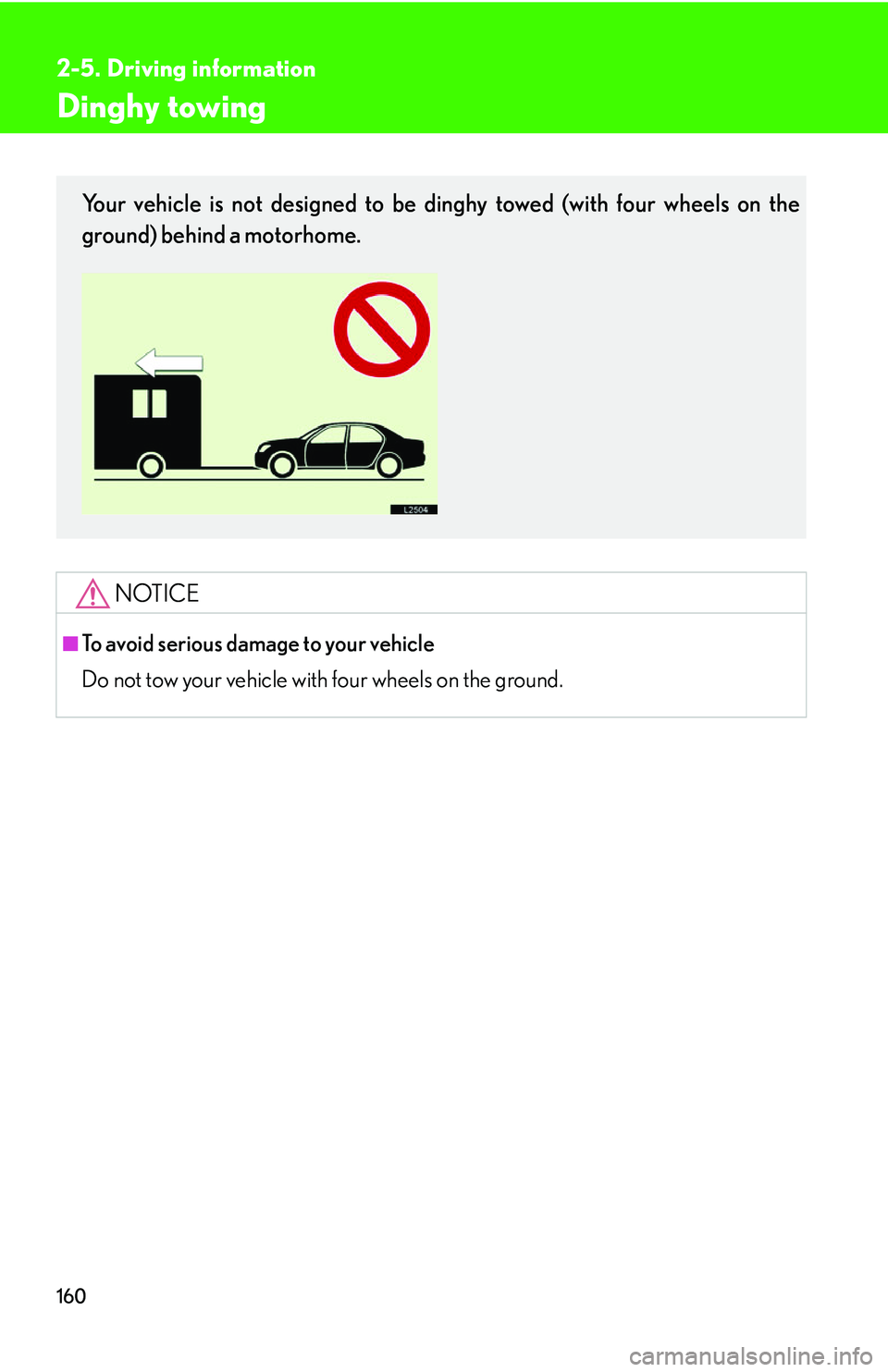
160
2-5. Driving information
Dinghy towing
NOTICE
■To avoid serious damage to your vehicle
Do not tow your vehicle with four wheels on the ground.
Your vehicle is not designed to be dinghy towed (with four wheels on the
ground) behind a motorhome.
Page 177 of 419
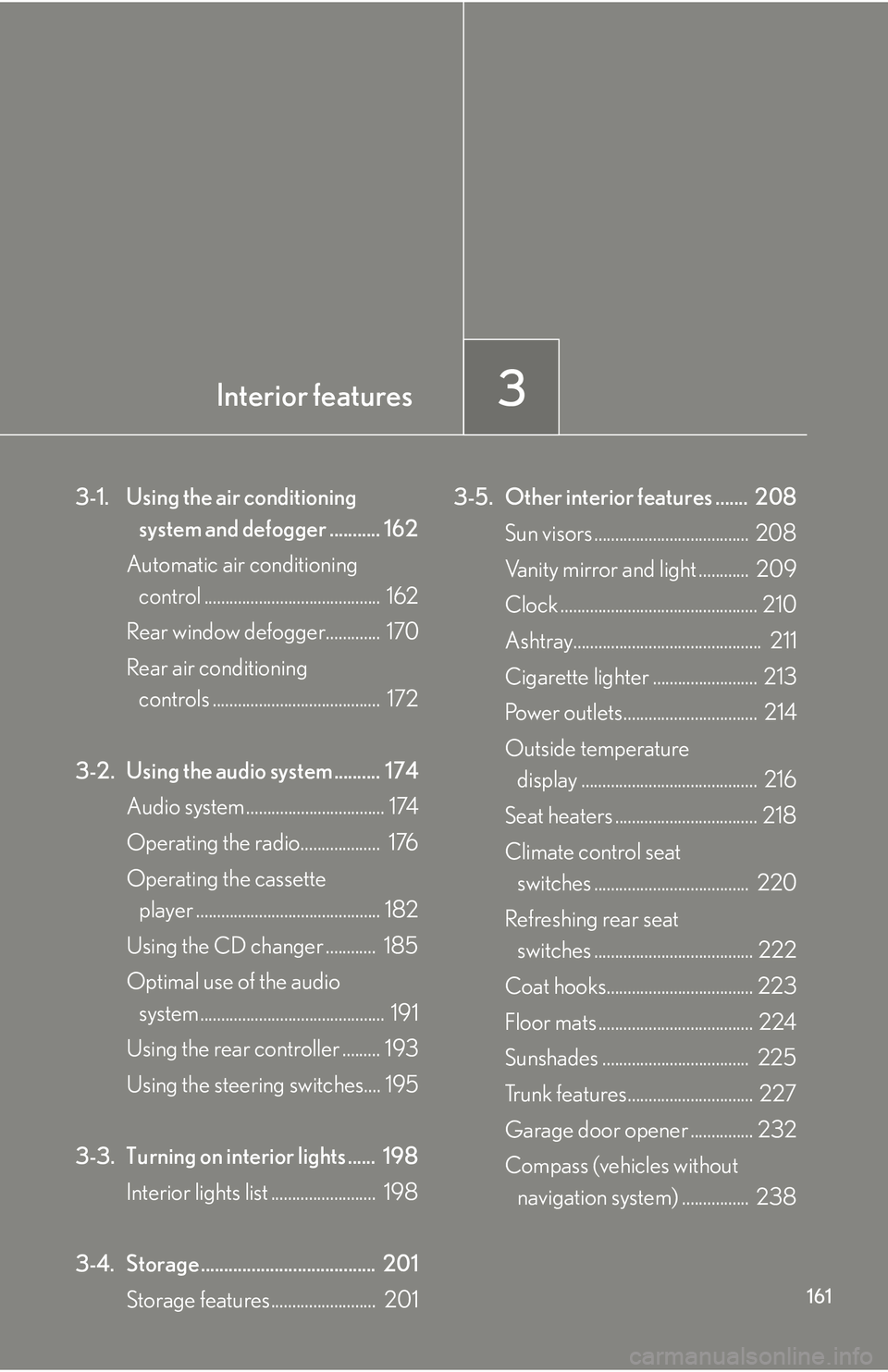
3Interior features
161
3-1. Using the air conditioning
system and defogger ........... 162
Automatic air conditioning
control .......................................... 162
Rear window defogger............. 170
Rear air conditioning
controls ........................................ 172
3-2. Using the audio system .......... 174 Audio system ................................. 174
Operating the radio................... 176
Operating the cassette
player ............................................ 182
Using the CD changer ............ 185
Optimal use of the audio
system ............................................ 191
Using the rear controller ......... 193
Using the steering switches.... 195
3-3. Turning on interior lights ...... 198 Interior lights list ......................... 198
3-4. Storage ...................................... 201 Storage features......................... 201 3-5. Other interior features ....... 208
Sun visors ..................................... 208
Vanity mirror and light ............ 209
Clock ............................................... 210
Ashtray............................................. 211
Cigarette lighter ......................... 213
Power outlets................................ 214
Outside temperature display .......................................... 216
Seat heaters .................................. 218
Climate control seat
switches ..................................... 220
Refreshing rear seat
switches ...................................... 222
Coat hooks................................... 223
Floor mats ..................................... 224
Sunshades ................................... 225
Trunk features.............................. 227
Garage door opener ............... 232
Compass (vehicles without
navigation system) ................ 238
Page 178 of 419
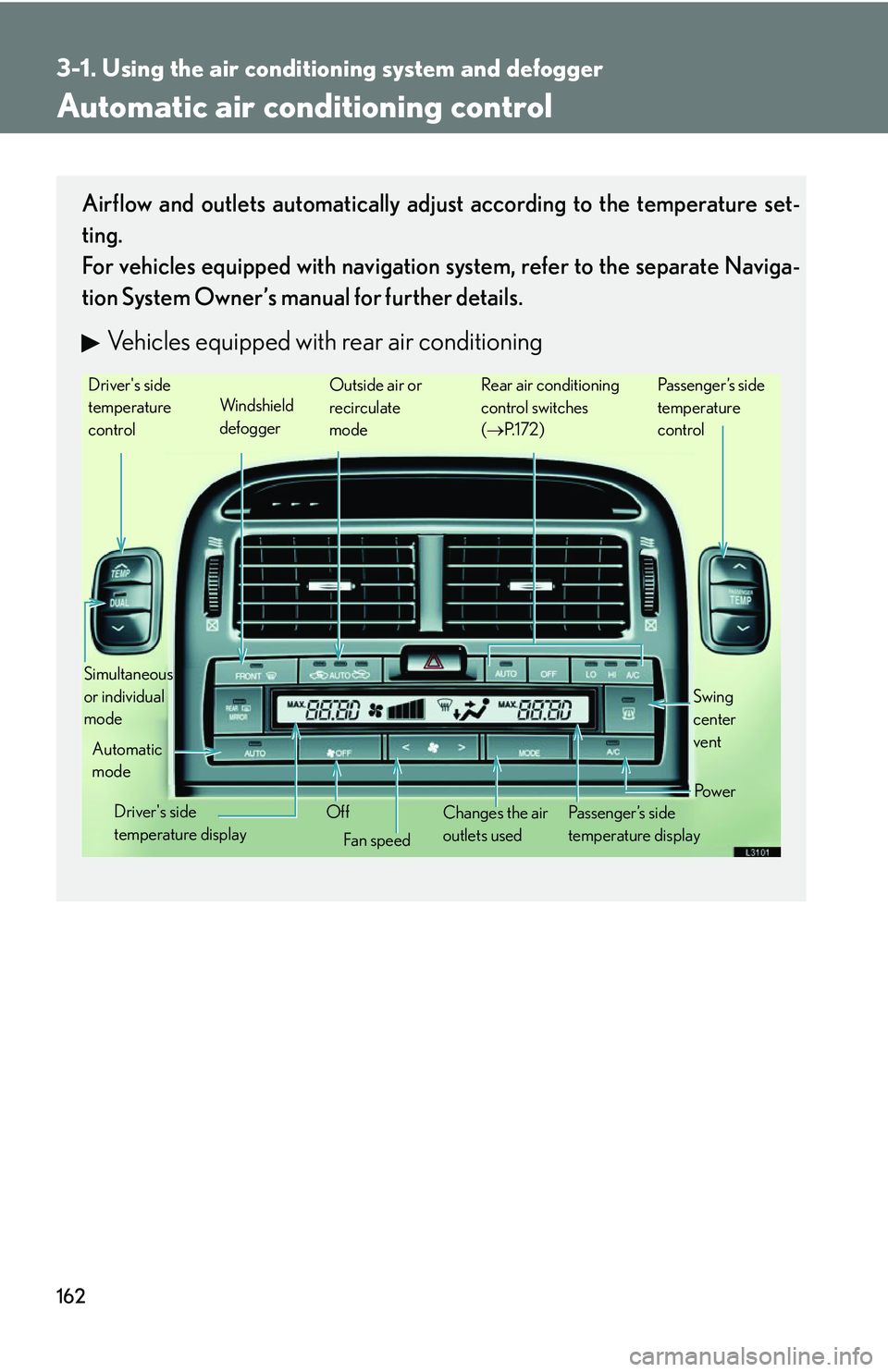
162
3-1. Using the air conditioning system and defogger
Automatic air conditioning control
Airflow and outlets automatically adjust according to the temperature set-
ting.
For vehicles equipped with navigation sy
stem, refer to the separate Naviga-
tion System Owner’s manual for further details.
Vehicles equipped with rear air conditioning
Driver's side
temperature
control
Simultaneous
or individual
mode Winds hield
defogger
Automatic
mode
Driver's side
temperature display Off
Fan speed Changes the air
outlets used Passenger’s side
temperature display Swing
center
vent
Po w e r
Passenger’s side
temperature
control
Rear air conditioning
control switches
( P. 1 7 2 )
Outside air or
recirculate
mode
Page 179 of 419
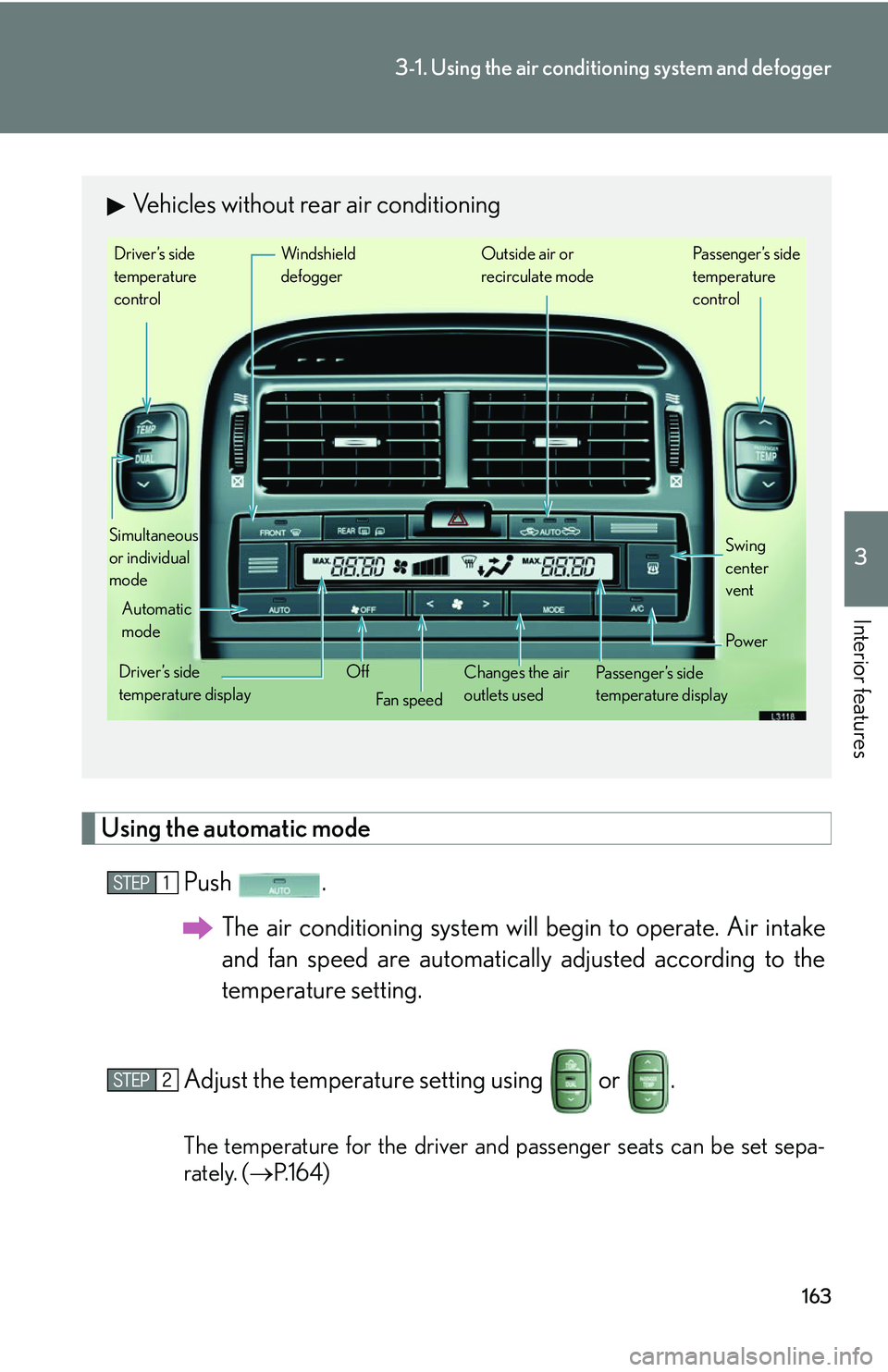
163
3-1. Using the air conditioning system and defogger
3
Interior features
Using the automatic mode
Push .
The air conditioning system will begin to oper
ate. Air intake
and fan speed are automatically adjusted accor
ding to the
temperature setting.
Adjust the temperature setting using or .
The temperature for the driver and passenger seats can be set sepa -
rately. ( P.164
)
Vehicles without rear air conditioning
Driver’s side
temperature
control
Simultaneous
or individual
mode Windshield
defogger Outside air or
recirculate mode
Automatic
mode
Driver’s side
temperature display Off
Fan speed Changes the air
outlets used Passenger’s side
temperature display Po w e r
Passenger’s side
temperature
control
Swing
center
vent
Page 180 of 419
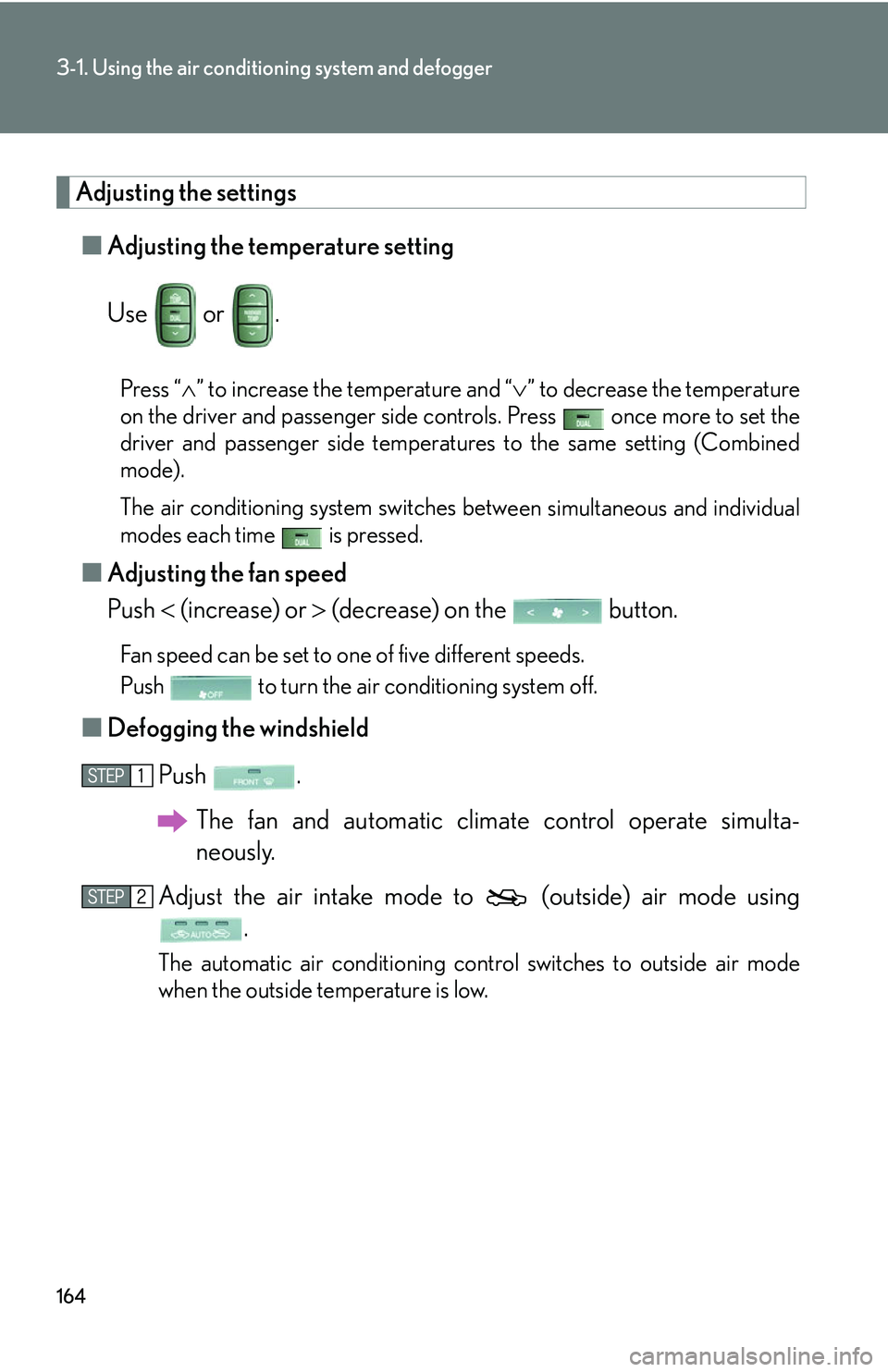
164
3-1. Using the air conditioning system and defogger
Adjusting the settings
■Adjusting the temperature setting
Use or .
Press “ ” to increase the temperature and “ ” to decrease the temperature
on the driver and passenger side controls. Press once more to set the
driver and passenger side temperatures to the same setting (Combined
mode).
The air conditioning system switches betw
een simultaneous and individual
modes each time is pressed.
■Adjusting the fan speed
Push (incr
ease) or (decrease) on the button.
Fan speed can be set to one of five different speeds.
Push to turn the air conditioning system off.
■Defogging the windshield
Push .
The fan and automatic clima te contr
ol operate simulta-
neously.
Adjust the air intake mode to (outside) air mode using
.
The automatic air conditioning cont rol switches to outside air mode
when the outside temperature is low.